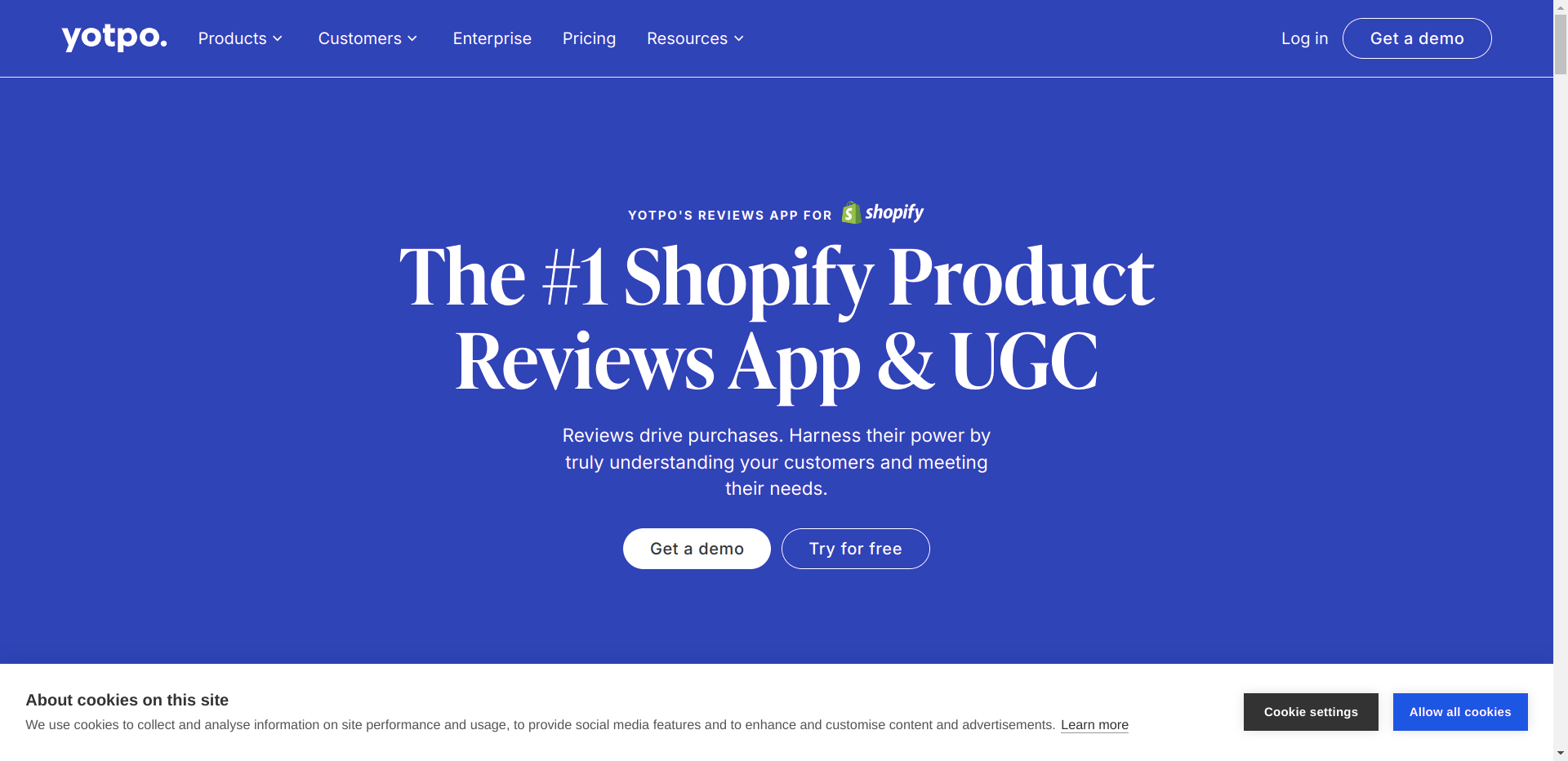7 Best Shopify Apps for User-Generated Content in 2025
You scroll through a store and there appear actual customer images. Such real photographs leave you more confident in the product. By 2025, Shopify stores have revolutionised, owing to the user-generated content (UGC). It creates a sense of trustworthiness and motivates purchases via the actual experiences of customers. It is possible to facilitate the collection and presentation of UGC with using apps such as Yotpo.
Consumers are hungry for reality as opposed to smooth advertising. Reviews and photos affiliate themselves with UGC, which also feels authentic. Studies reveal that it increases conversions by 30%. UGC is made manageable via the tools offered by Yotpo. The lack of it causes the stores to lose credibility. In this manual, I will explore technical methods of getting UGC to pave the way to success even in 2025.

What is User-Generated Content?
Customer reviews, photos and videos generated by the users are categorized under user generated content. It is found on social media, product pages or blogs. In comparison with the brand-made material, UGC represents the real-life experiences of users. Yotpo platform captures and presents this kind of content on the Shopify stores, improving them.
The popularity of UGC increases due to loss of confidence in the advertisements. It takes the role of social evidence, raising the click-through rates by 40%. Lacking UGC, the stores appear to be less trustworthy, which decreases conversions. The AI used by Yotpo selects only pertinent content and makes it quality. That is why UGC will be critical in 2025 when it comes to connecting with customers.
7 Best Shopify Apps for User-Generated Content:
1. Yotpo for Shopify UGC
Yotpo for Shopify UGC is a platform to gather reviews, photographs, and videos through automated messages. UGC is demanded in post-purchase emails as a result of increasing its submission. AI can moderate content, making them of quality and relevance. This creates a strong UGC library.
The API of Yotpo is integrated with Shopify which embeds shoppable galleries. JavaScript widgets also show UGC on product pages and help to raise conversions by 25%. The analytics used to track engagement, have perfected the placement of content. As scalability is in the cloud, thousands of submissions are taken care of in a day which makes it efficient.
2. Social Media Galleries
The social media UGC can be converted into sales through shoppable galleries. APIs use hashtags and retrieve photos of customers on the platforms. AI filters guarantee the quality of the relevant content. Shopify uses JavaScript in galleries present on product pages.
Social media is authenticated by the use of OAuth. The galleries have click-to-buy links that lessen the purchase friction. Analytics monitor interaction, and subsequently optimise photo placement. 15% increase in conversions is observed with the help of shoppable galleries due to social proof.
3. Automated Review collection tools
Review tools gather user generated content such as photos and ratings. The post purchase emails request feedback. Order information is synchronized via APIs, making the requests individualized. With AI acting as a moderator of submissions, there is relevance and quality.
SMTP servers present quick emails. Reviews are shown on the product pages with the help of JavaScript widgets. Review-based conversions are monitored, and prompts are improved through analytics. Automated reviews generate trust which leads to an increment in sales of 20%.
4. The Best Shopify Loyalty App
The principle behind loyalty apps creating UGC is the need to reward. Photos or reviews aid in earning points by customers. The APIs monitor user activities and attach rewards to the UGC posts. Machine learning also individualizes rewards stimulus, thus encouraging participation.
Javascript widgets show the progress of rewards on dashboards. Webhooks cause notifications through SMS or email. Analytics track the submissions and redemption of UGC and optimize strategies. The Best Shopify Loyalty App will increase 20% engagement creating better trust.
5. Photo contests websites
Photo contest apps capture the attention of the users by use of UGC. On the web forms, customers post pictures. AI uses quality and relevancy to judge entries. Contests, shared with APIs across social media, reach more people.
HTML5 forms can gather submission with metadata. With JavaScript leaderboards, you will see the top entries in real-time. Contests have their engagements tracked by analytics; optimizing the campaigns. Competitions raise UGC by 40%, which makes it increase activity.
6. Email UGC Integration Marketing
UGC is used in campaigns through email. On the review platforms, APIs can be used to retrieve the customer photos. Dynamic content blocks present UGC according to the actions of the user. SMTP servers guarantee delivery of mail.
CSS also establishes responsiveness in designing emails. UGC is placed using A/B testing. Open rates and conversions are measured by analytics and campaigns optimized. The presence of UGC increases interactivity in emails by 20%.
7. Social Proof Widgets
The UGC such as reviews can be seen as social proof widgets. APIs are used to retrieve social sites or review content. JavaScript is used to put widgets in Shopify pages. Only quality UGC is expected to emerge through AI.
The lazy-loading process enhances swiftness in pages. Widget interaction tracking in the context of Heatmap analytics leads to better placement. By using original content Widgets increase conversions adding 30%.
Why UGC Matters:
1.The Grounds of Power of Authenticity
In 2025, shoppers will insist on having real experiences. Perfected advertisements make customers feel brushed and unfamiliar. Real life E.g. Customer photos User-generated content (UGC) makes customers more likely to trust the product because they are shown in real life. Through their platform, Yotpo automates the process of collecting UGC which eases the integration process to store owners on the Shopify platform. This genuineness generates participation and devotion.
The API of Yotpo requests content on social sites through OAuth. There is AI filtration such that only quality photos and reviews can be shown. Analytics monitors the UGC sales and reveals that UGC sales give a 20 per cent increase in conversion. The absence of UGC means that stores do not have social proof that can make them lack sales. The JavaScript widgets of Yotpo integrate content into one, thus benefiting user experience.
The lack of observance of UGC provokes mistrust. Customers prefer authentic content in competition. Real-time moderation in Yotpo makes the UGC relevant and keeps it of quality. This is the technical accuracy that makes UGC essential to the success of Shopify in 2025 to stimulate sales and credibility.
2.Increasing the Conversion Rates
In 2025, UGC results in a large boost in conversions. Photos and reviews by customers are social evidence, which helps motivate sales. Research indicates that UGC increases click-through by 40%. The tools by Yotpo gather this content properly and stream it in Shopify stores to make them work better.
UGC on product pages are done through APIs using dynamic HTML. Machine learning prioritizes the content based on its relevance thus making it effective. There are engagement analytics dashboards to optimize placement. Without the UGC, the stores miss 25% in conversion, as buyers want the social confirmation. The automation provided by Yotpo supports consistent and quality components of content delivery.
The inability to utilize UGC undermines sales. People believe more in customers than they believe in advertisements and this is used by the competitors. Yotpo real-time analytics optimize UGC tactics and make them ROI-maximized. This will put UGC as one of the greatest drivers of conversions in 2025.
3.Customer Trust Building
The concept of trust plays a very important role in the competitive market of 2025. The same principle applies to the UGC in terms of user videos, which gain credibility through depicting real experiences. Customers believe in peer content more than brand advertisements (50%). The platform of Yotpo aggregates UGC, enhancing the loyalty of Shopify stores.
It uses AI based moderation of submissions, of low quality content. ECommerce platforms are synced with APIs utilizing UGC by embedding it with widgets. With UGC, travel analytics increase trust measurements such as dwell time by 15%. In its absence, stores lose some credibility and lose customers.
Inefficient use of UGC means loss of brand detachment. Consumers can resort to the competitors with healthy UGC. Yotpo moderation on its side guarantees credible content, which strengthens credibility. Such technological lead cements customer confidence that is crucial to success in 2025.
4.Social Engagement
In 2025, UGC fills the social space. The reach of the brand is increased with customer photos on the platforms. Hashtag campaigns gather UGC, inviting the user to take part. This is simplified by the tools provided by Yotpo, which ratchets up engagement in Shopify stores.
APIs access social content by means of secure tokens. JavaScript and shoppable galleries make the connection between UGC and products. Analytics followed the social shares, and the engagement rate increased by 30%. Brands will not reach a wide audience without UGC. The automation employed by Yotpo makes campaigns more effective.
The lack of attitude towards social UGC decreases interaction. Brands who do not actively use UGC lose followers. Yotpo has live integration to keep the content new, which stimulates activity. This implies that UGC will be the key to a successful social life in 2025.
Conclusion
In 2025, Shopify stores will be changed with user-generated content. It helps in the creation of trust and increases conversions. Yotpo is the leader in using AI to automate the UGC collection. These seven apps assist in improving interaction through galleries to competitions. APIs and analytics and other technical features guarantee scalability. UGC that is ignored would result in loss of customer trust.
The businesses should consider using these apps now. The integration of social proof widgets, loyalty rewards and email ensure sales. UGC based on data helps to establish genuine relationships. These apps are needed to make Shopify a success and keep the customers glued to them in 2025.

